Effect of Temperature Changes on the Vibration Transmissibility of XPE and PE Packaging Cushioning Material
Abstract
:1. Introduction
- Define the shipping environment
- 2.
- Define product fragility
- 3.
- Improve the robustness of the product
- 4.
- Evaluate the performance of cushioning material
- 5.
- Packaging design
- 6.
- Test and validate the packaged-product system
2. Materials and Method
2.1. Experimental Materials
2.2. Method for Conditioning
2.3. Method for Static Load
2.4. Method for Vibration Transmissibility
2.5. Method for Estimation of Damping Ratio
- Preparation of the samples and mass blocks (size, weight)
- Conditioning of the elements (temperature, time)
- Assembly of the measurement system (fixture, static stress)
- Parameter setting and setup of the vibration measurement (frequency band, sweep rate, amplitude, frequency range)
- Expression of the measured and calculated results (applied equations, units).
3. Results and Discussion
3.1. Experimental Results
3.2. Findings from the Experimental Results
3.3. Analysis of the Experimental Results
3.4. Comparison to Expanded Polyethylene (EPE)
3.5. Comparison to Paper-Based Packaging
4. Conclusions
Author Contributions
Funding
Institutional Review Board Statement
Informed Consent Statement
Data Availability Statement
Conflicts of Interest
References
- Lu, F.; Gao, D. Impact Responses of Composite Cushioning System considering Critical Component with Simply Supported Beam Type. Adv. Mech. Eng. 2014, 6, 1–6. [Google Scholar] [CrossRef] [Green Version]
- Hanlon, J.; Kelsey, R.; Forcinio, H. Handbook of Package Engineering, 3rd ed.; Technomic Publishing Company Inc.: Boca Raton, FL, USA, 1998. [Google Scholar]
- Yam, K.L. The Wiley Encyclopedia of Packaging Technology, 2nd ed.; John Wiley & Sons: Hoboken, NJ, USA, 2010. [Google Scholar]
- Guo, Y.; Xu, W.; Fu, Y.; Wang, H. Dynamic shock cushioning characteristics and vibration transmissibility of X-PLY corrugated paperboard. Shock Vib. 2011, 18, 525–535. [Google Scholar] [CrossRef]
- Sherman, M. Medical Device Packaging Handbook, 1st ed.; CRC Press: Boca Raton, FL, USA, 1988. [Google Scholar]
- Böröcz, P.; Singh, S.P. Measurement and analysis of delivery van vibration levels to simulate package testing for parcel delivery in Hungary. Packag. Technol. Sci. 2018, 31, 342–352. [Google Scholar] [CrossRef]
- Parker, A.J. A Method of Characterisation of the Nonlinear Vibration Transmissibility of Cushioning Materials. Ph.D. Thesis, Victoria University, Melbourne, Australia, 2007. Available online: http://vuir.vu.edu.au/id/eprint/1531 (accessed on 1 December 2020).
- Gibson, I.J.; Ashby, M.F. The Mechanics of Three-Dimensional Cellular Materials. Proc. R. Soc. Lond. A 1982, 382, 43–59. [Google Scholar] [CrossRef]
- Maiti, S.K.; Gibson, L.J.; Ashby, M.F. Deformation and energy absorption diagrams for cellular solids. Acta Metall. 1984, 32, 1963–1975. [Google Scholar] [CrossRef]
- Gibson, L.J. Modelling the mechanical behavior of cellular materials. Mater. Sci. Eng. A 1989, 110, 1–36. [Google Scholar] [CrossRef]
- Ozturk, U.E.; Anlas, G. Energy absorption calculations in multiple compressive loading of polymeric foams. Mater. Des. 2009, 30, 15–22. [Google Scholar] [CrossRef]
- Zhang, J.; Kikuchi, N.; Li, V.; Yee, A.; Nusholtz, G. Constitutive modeling of polymeric foam material subjected to dynamic crash loading. Int. J. Impact Eng. 1998, 21, 369–386. [Google Scholar] [CrossRef]
- Avalle, M.; Belingardi, G.; Ibba, A. Mechanical models of cellular solids: Parameters identification from experimental tests. Int. J. Impact Eng. 2007, 34, 3–27. [Google Scholar] [CrossRef]
- Sherwood, J.A.; Frost, C.C. Constitutive modeling and simulation of energy absorbing polyurethane foam under impact loading. Polym. Eng. Sci. 1992, 32, 1138–1146. [Google Scholar] [CrossRef]
- Avallea, M.; Belingardia, G.; Montaninib, R. Characterization of polymeric structural foams under compressive impact loading by means of energy-absorption diagram. Int. J. Impact Eng. 2001, 25, 455–472. [Google Scholar] [CrossRef]
- Miltz, J.; Ramon, O. Energy absorption characteristics of polymeric foams used as cushioning materials. Polym. Eng. Sci. 1990, 30, 129–133. [Google Scholar] [CrossRef]
- Andena, L.; Caimmi, F.; Leonardi, L.; Nacucchi, M.; De Pascalis, F. Compression of polystyrene and polypropylene foams for energy absorption applications: A combined mechanical and microstructural study. J. Cell. Plast. 2019, 55, 49–72. [Google Scholar] [CrossRef]
- Woolam, W.E. A Study of the Dynamics of Low Energy Cushioning Materials Using Scale Models. J. Cell. Plast. 1968, 4, 79–83. [Google Scholar] [CrossRef]
- Zhang, J.; Ashby, M.F. Mechanical selection of foams and honeycombs used for packaging and energy absorption. J. Mater. Sci. 1994, 29, 157–163. [Google Scholar] [CrossRef]
- Jalil, S.A. Optimization of 3D Printable Cellular Array Structures for Cushioning. Ph.D. Thesis, Nanyang Technological University, Singapore, 2019. [Google Scholar] [CrossRef]
- Navarro-Javierre, P.; Garcia-Romeu-Martinez, M.A.; Cloquell-Ballester, V.A.; de-la-Cruz-Navarro, E. Evaluation of Two Simplified Methods for Determining Cushion Curves of Closed Cell Foams. Packag. Technol. Sci. 2012, 25, 217–231. [Google Scholar] [CrossRef]
- Ruiz-Herrero, J.L.; Rodríguez-Pérez, M.A.; de Saja, J.A. Prediction of Cushion Curves for Closed Cell Polyethylene-Based Foams. Part I. Modelling. Cell. Polym. 2005, 24, 329–346. [Google Scholar] [CrossRef]
- Ge, C. Theory and practice of cushion curve: A supplementary discussion. Packag. Technol. Sci. 2019, 32, 185–197. [Google Scholar] [CrossRef]
- Gruenbaum, G.; Miltz, J. Static versus dynamic evaluation of cushioning properties of plastic foams. J. Appl. Polym. Sci. 1983, 28, 135–143. [Google Scholar] [CrossRef]
- Ramon, O.; Miltz, J. Prediction of dynamic properties of plastic foams from constant–strain rate measurements. J. Appl. Polym. Sci. 1990, 40, 1683–1692. [Google Scholar] [CrossRef]
- Iannace, F.; Iannace, S.; Caprino, G.; Nicolais, L. Prediction of impact properties of polyolefin foams. Polym. Test. 2001, 20, 643–647. [Google Scholar] [CrossRef]
- Daum, M. A simplified process for determining cushion curves: The stress–energy method. In Dimensions 2006; International Safe Transit Association: East Lansing, MI, USA, 2006. [Google Scholar]
- Burgess, G. Generation of cushion curves from one shock pulse. Packag. Technol. Sci. 1994, 7, 169–173. [Google Scholar] [CrossRef]
- Daum, M. Simplified Presentation of the Stress-Energy Method for General Commercial Use. J. Test. Eval. 2008, 36, 100–102. [Google Scholar] [CrossRef]
- Paulin, K.; Batt, G.; Daum, M. Statistical Analysis of the Stress-Energy Methodology Applied to Cushion Curve Determination. J. Test. Eval. 2013, 41, 409–416. [Google Scholar] [CrossRef] [Green Version]
- Singh, J.; Ignatova, L.; Olsen, E.; Singh, P. Evaluation of the Stress-Energy Methodology to Predict Transmitted Shock through Expanded Foam Cushions. J. Test. Eval. 2010, 38, 724–730. [Google Scholar] [CrossRef]
- Daum, M. Evaluation of Predicted Deceleration Values From the Stress-Energy Method Compared to Actual Deceleration Values From the ASTM D1596 Test Method. J. Test. Eval. 2011, 39, 1103–1108. [Google Scholar] [CrossRef]
- McGee, S.D.; Batt, G.S.; Gibert, J.M.; Darby, D.O. Predicting the effect of temperature on the shock absorption properties of polyethylene foam. Packag. Technol. Sci. 2017, 30, 477–494. [Google Scholar] [CrossRef]
- Sek, M.A.; Minett, M.; Rouillard, V.; Bruscella, B. A new method for the determination of cushion curves. Packag. Technol. Sci. 2000, 13, 249–255. [Google Scholar] [CrossRef]
- Li, G.; Rouillard, V.; Sek, M.A. Evaluation of Static and Dynamic Cushioning Properties of Polyethylene Foam for Determining Its Cushion Curves. Packag. Technol. Sci. 2015, 28, 47–57. [Google Scholar] [CrossRef]
- Gibert, J.; Batt, G. Impact oscillator model for the prediction of dynamic cushion curves of open cell foams. Packag. Technol. Sci. 2015, 28, 227–239. [Google Scholar] [CrossRef]
- Mills, N.J.; Masso-Moreu, Y. Finite element analysis (FEA) applied to polyethylene foam cushions in package drop tests. Packag. Technol. Sci. 2005, 18, 29–38. [Google Scholar] [CrossRef]
- Ozturka, U.E.; Anlas, G. Finite element analysis of expanded polystyrene foam under multiple compressive loading and unloading. Mater. Des. 2011, 32, 773–780. [Google Scholar] [CrossRef]
- Kuang, W.; Wang, J.; Huang, C.; Lu, L.; Gao, D.; Wang, Z.; Ge, C. Homotopy perturbation method with an auxiliary term for the optimal design of a tangent nonlinear packaging system. J. Low Freq. Noise Vib. Act. Control 2019, 38, 1075–1080. [Google Scholar] [CrossRef]
- Ji, Q.; Wang, J.; Lu, L.; Ge, C. Li–He’s modified homotopy perturbation method coupled with the energy method for the dropping shock response of a tangent nonlinear packaging system. J. Low Freq. Noise Vib. Act. Control 2020. [Google Scholar] [CrossRef]
- Ge, C.; Rice, B. Impact damping ratio of a nonlinear viscoelastic foam. Polym. Test. 2018, 72, 187–195. [Google Scholar] [CrossRef]
- Ge, C.; Cormier, D.; Rice, B. Damping and cushioning characteristics of Polyjet 3D printed photopolymer with Kelvin model. J. Cell. Plast. 2020. [Google Scholar] [CrossRef]
- ASTM International. ASTM D1596: Standard test method for dynamic cushion shock cushioning characteristics of packaging material. In Annual Book of ASTM Standards; ASTM International: West Conshohocken, PA, USA, 2014. [Google Scholar]
- ASTM International. ASTM D4168: Standard test methods for transmitted shock characteristics of foam-in-place cushioning materials. In Annual Book of ASTM Standards; ASTM International: West Conshohocken, PA, USA, 2015. [Google Scholar]
- Batt, G. Primary Resonance Behavior of Expanded Polymer Cushion Material under Low-Intensity Harmonic Excitations. Ph.D. Thesis, Clemson University, Clemson, SC, USA, 2013. Available online: https://tigerprints.clemson.edu/all_dissertations/1260 (accessed on 1 December 2020).
- Goodwin, D.; Young, D. Protective Packaging for Distribution; DEStech Publications Inc.: Lancaster, PA, USA, 2011. [Google Scholar]
- Guo, Y.; Zhang, J. Shock absorbing characteristics and vibration transmissibility of honeycomb paperboard. Shock Vib. 2004, 11, 521–531. [Google Scholar] [CrossRef]
- Wang, Z.W.; Wang, L.J.; Xu, C.Y.; Zhang, Y. Influence of Low-Intensity Repeated Impacts on Energy Absorption and Vibration Transmissibility of Honeycomb Paperboard. Packag. Technol. Sci. 2016, 29, 585–600. [Google Scholar] [CrossRef]
- Latif, N.A.; Rus, A.Z.M. Vibration Transmissibility Study of High Density Solid Waste Biopolymer Foam. J. Mech. Eng. Sci. 2014, 6, 772–781. [Google Scholar] [CrossRef]
- Godshall, W.D. Vibration Transmissibility Characteristics of Corrugated Fiberboard; Defense Technical Information Center: Fort Belvoir, VA, USA, 1973. [Google Scholar]
- Guo, Y.; Xu, W.; Fu, Y.; Zhang, W. Comparison Studies on Dynamic Packaging Properties of Corrugated Paperboard Pads. Engineering 2010, 2, 378–386. [Google Scholar] [CrossRef] [Green Version]
- Kim, J.N.; Sim, J.M.; Park, M.J.; Kim, G.S.; Kim, J.; Park, J.M. Analysis and Modelling of Vibration Performance for Multi-layered Corrugated Structure. Biosyst. Eng. 2013, 38, 327–334. [Google Scholar] [CrossRef]
- Sek, M.A.; Rouillard, V.; Parker, A.J. A Study of Nonlinear Effects in a Cushion-Product System on its Vibration Transmissibility Estimates with the Reverse Multiple Input–Single Output Technique. Packag. Technol. Sci. 2013, 26, 125–135. [Google Scholar] [CrossRef]
- White, S.W.; Kim, S.K.; Bajaj, A.K.; Davies, P.; Showers, D.K.; Liedtke, P.E. Experimental Techniques and Identification of Nonlinear and Viscoelastic Properties of Flexible Polyurethane Foam. Nonlinear Dyn. 2000, 22, 281–313. [Google Scholar] [CrossRef]
- Marcondes, J.; Hatton, K.; Graham, J.; Schueneman, H. Effect of temperature on the cushioning properties of some foamed plastic materials. Packag. Technol. Sci. 2003, 16, 69–76. [Google Scholar] [CrossRef]
- Szymanski, J. The Effect of Temperature and Humidity on the Cushioning Properties of Expanded Polylactic Acid Foam. Master’s Thesis, Clemson University, Clemson, SC, USA, 2010. [Google Scholar]
- Brandenburg, R.K.; Lee, J.J. Fundamentals of Packaging Dynamics; L.A.B. Equipment Inc.: Itasca, IL, USA, 2001. [Google Scholar]
- Harris, C.M.; Crede, E.E.; Hatae, M.T. Shock and Vibration Handbook, Packaging Design; McGraw-Hill Book Inc.: New York, NY, USA, 1961. [Google Scholar]
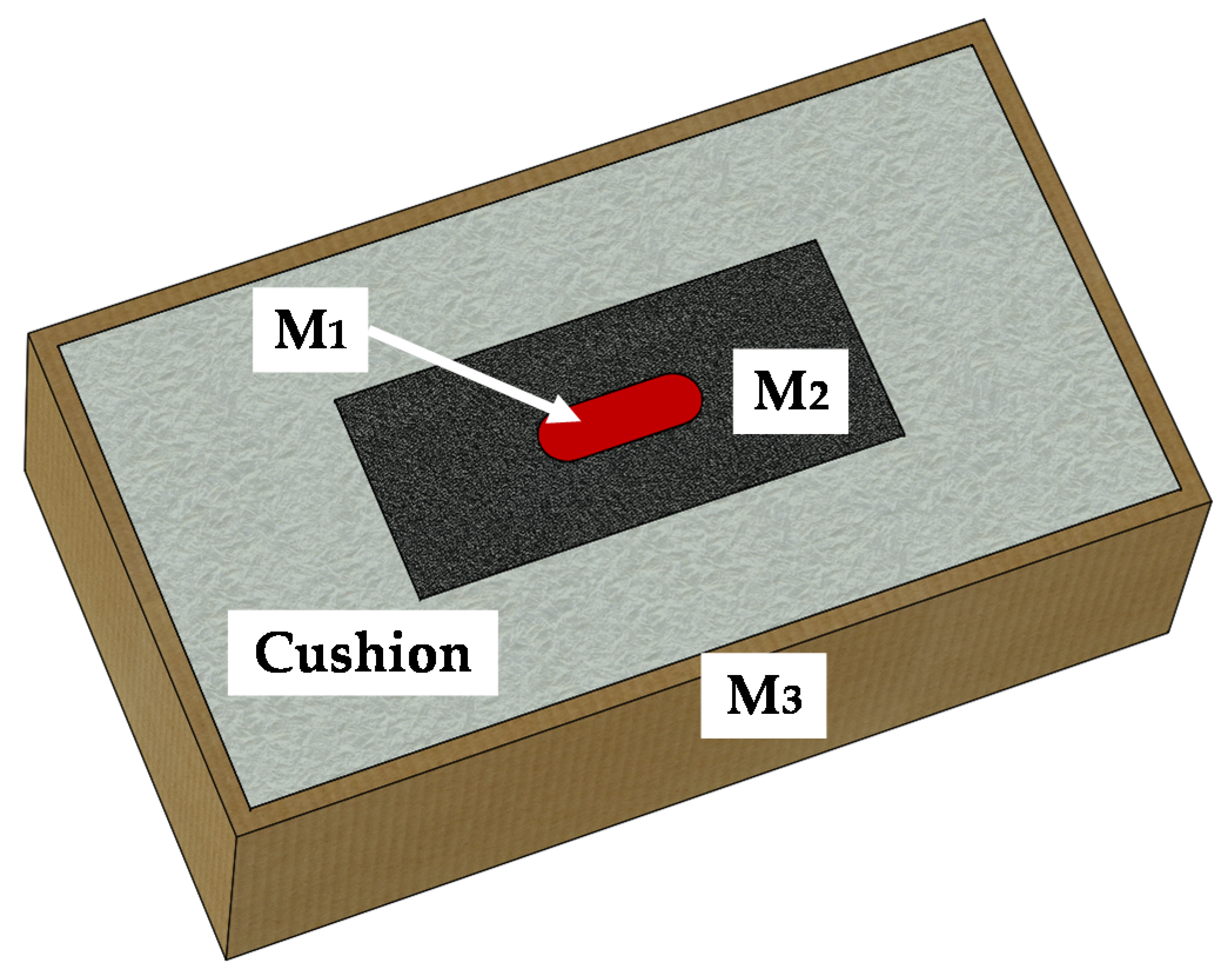
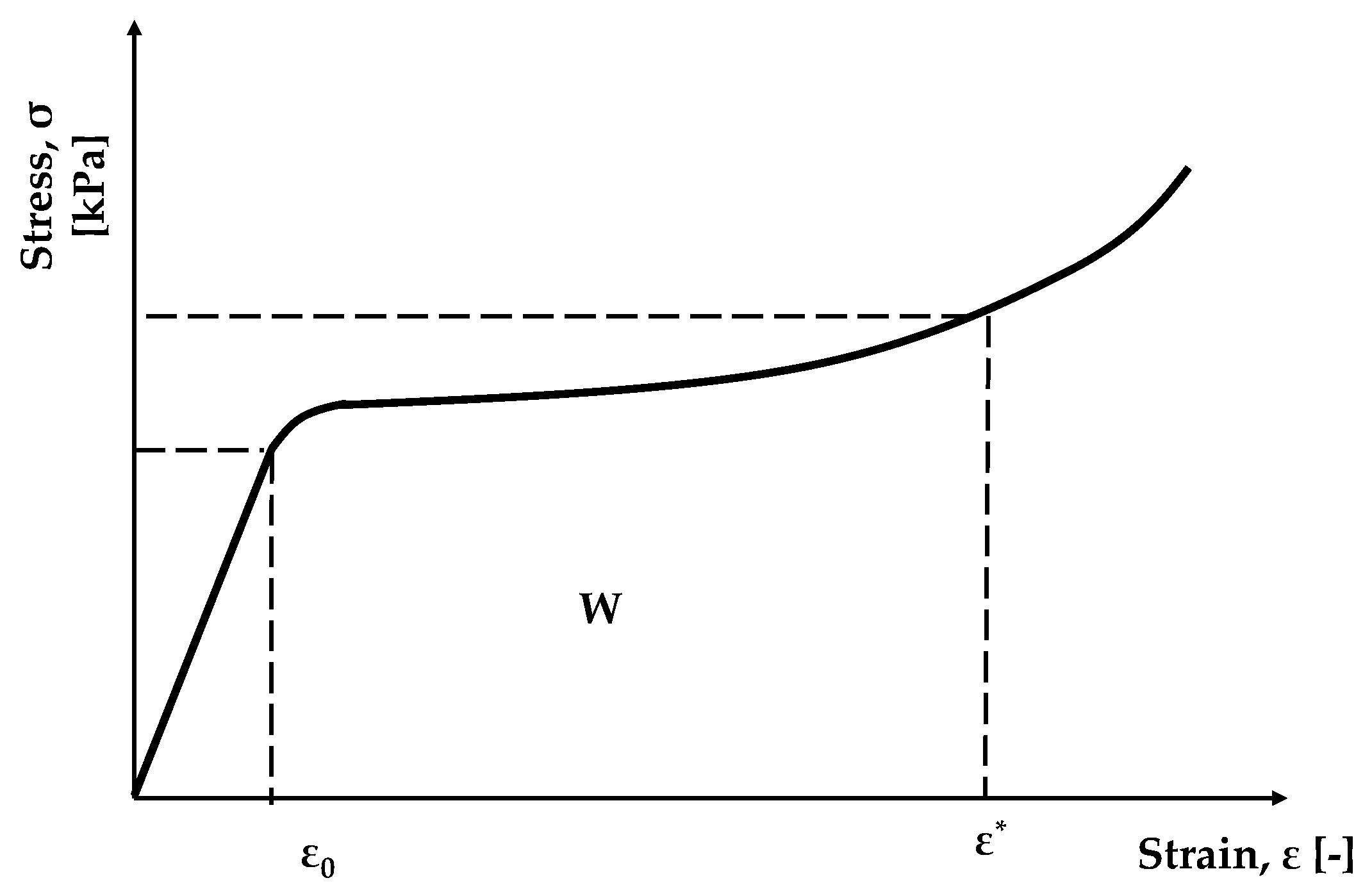

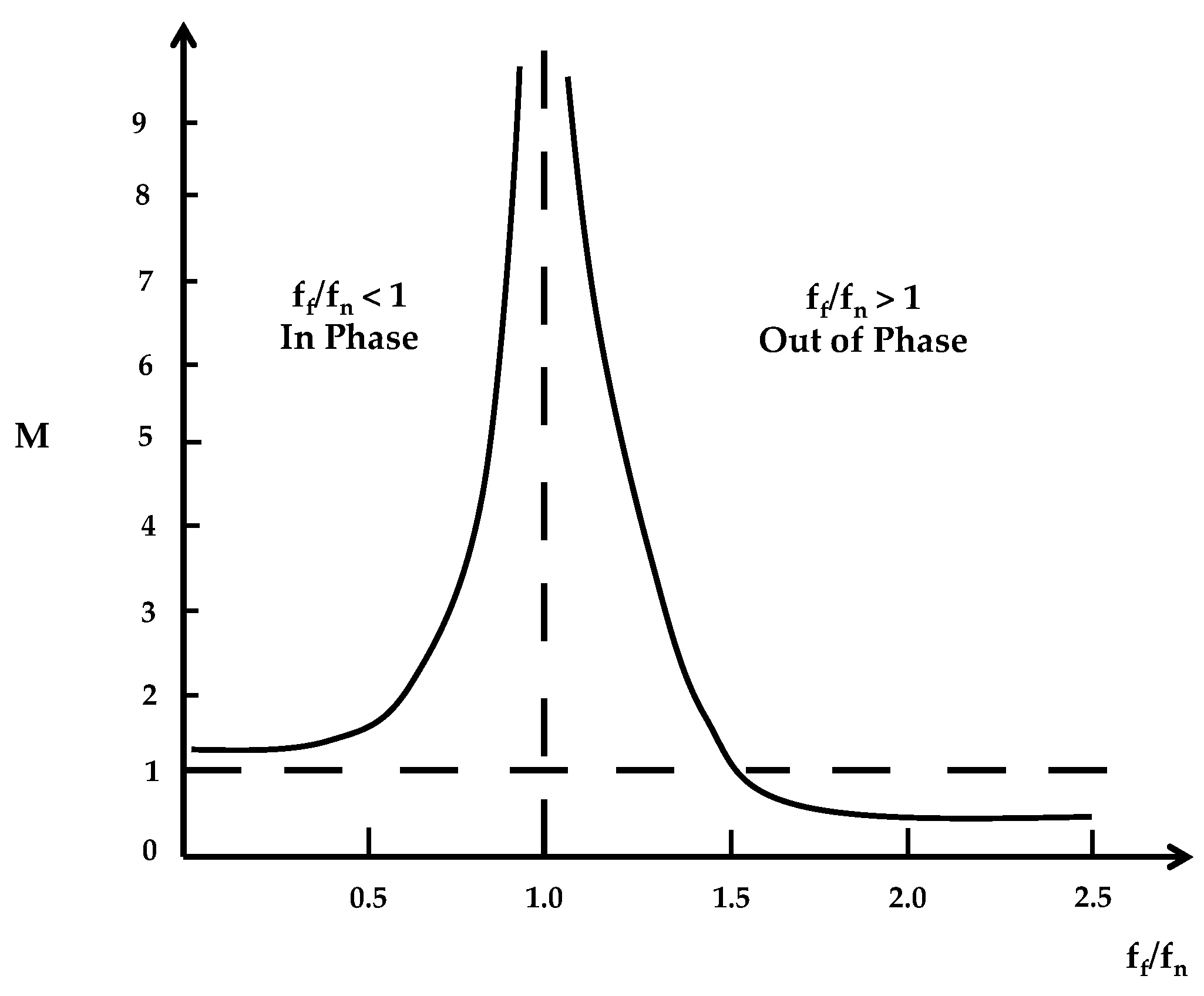
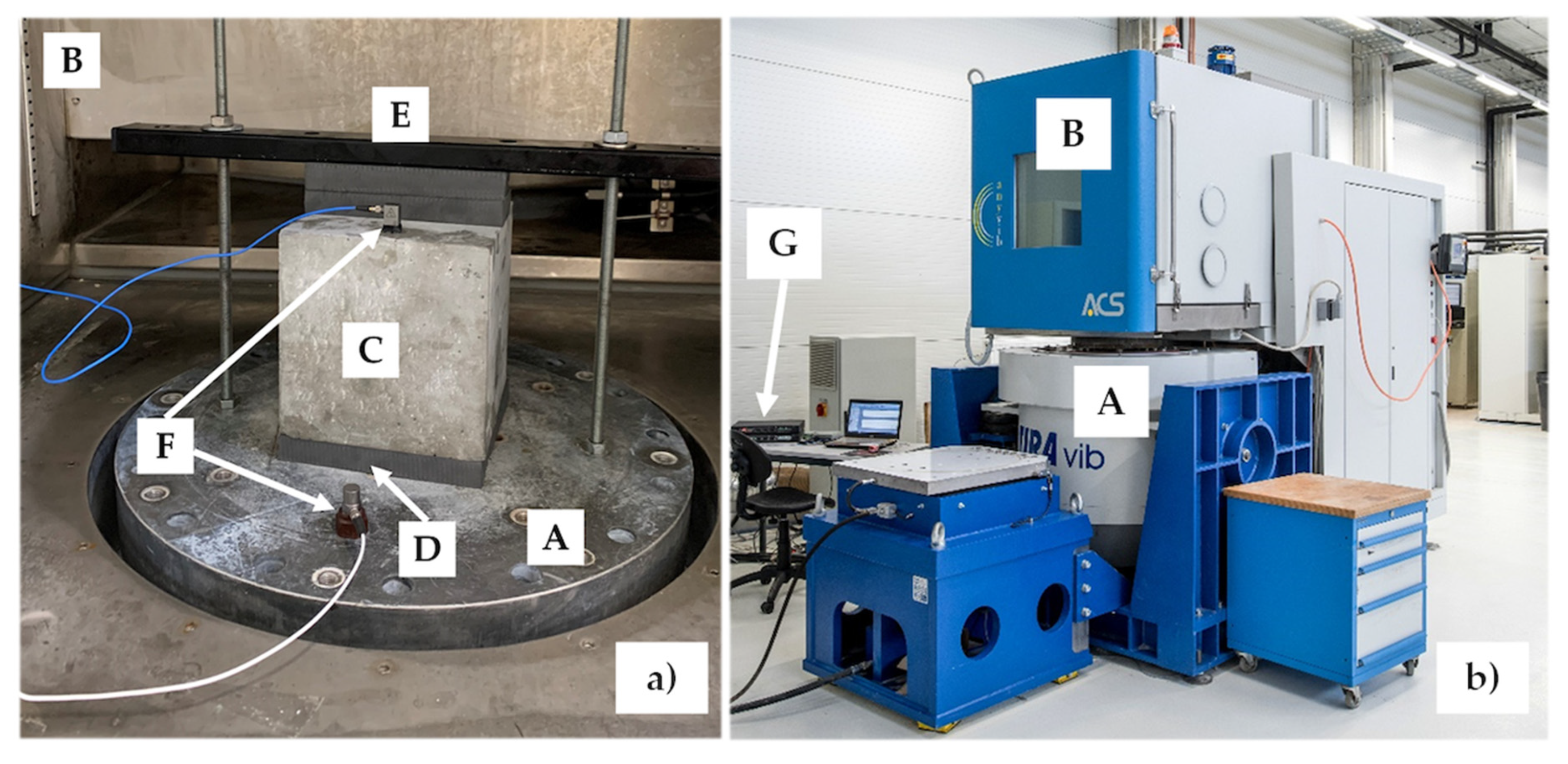
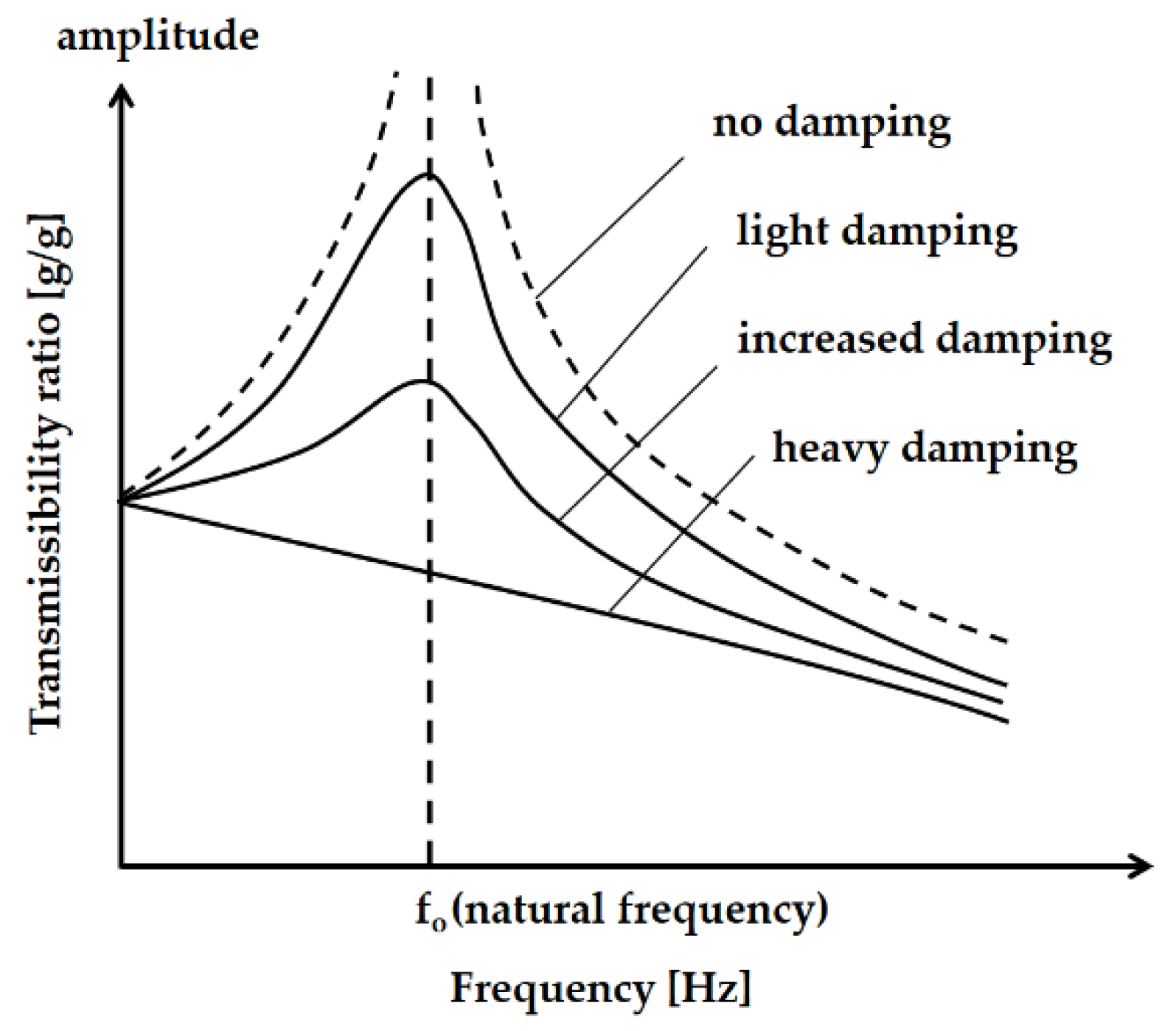
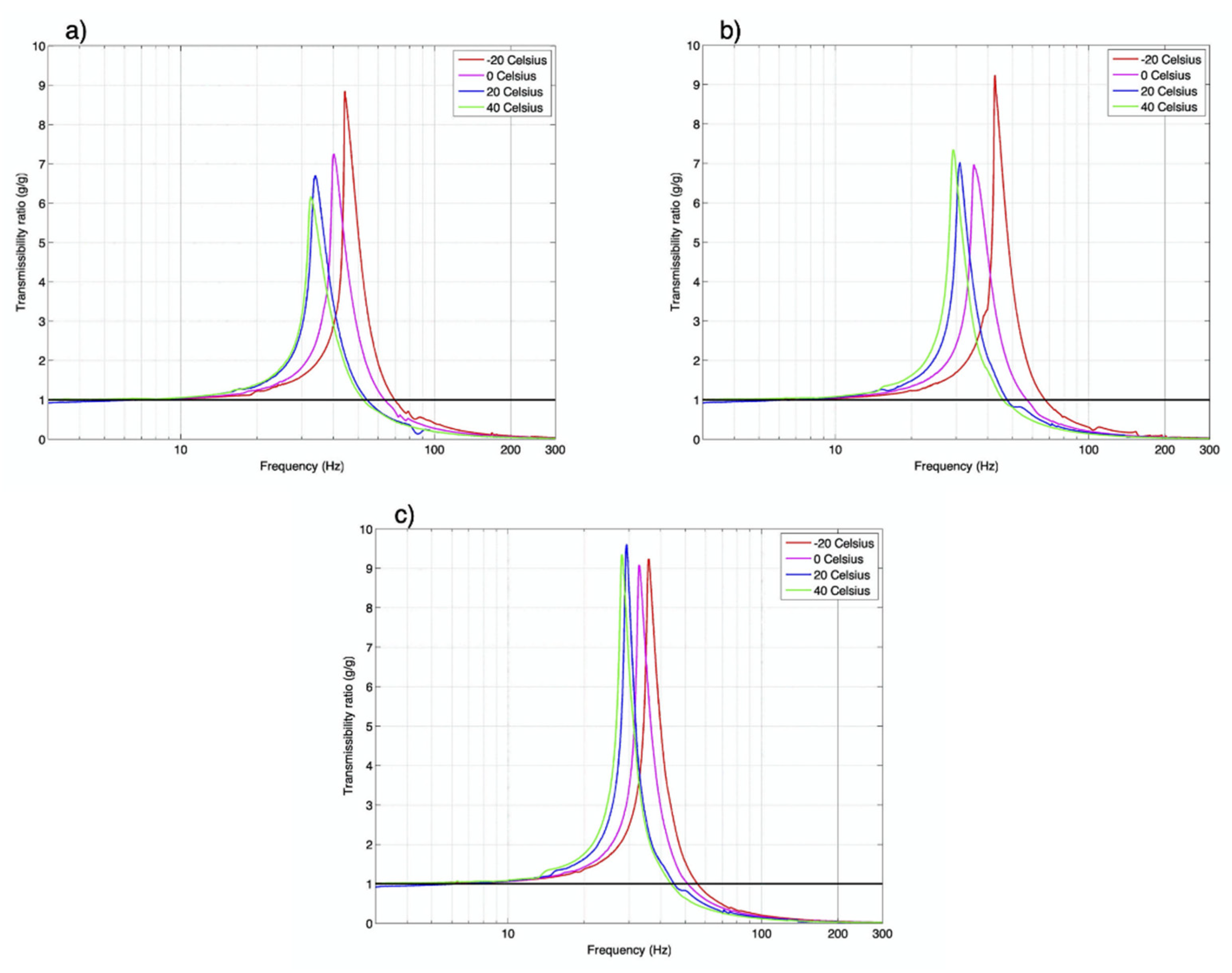
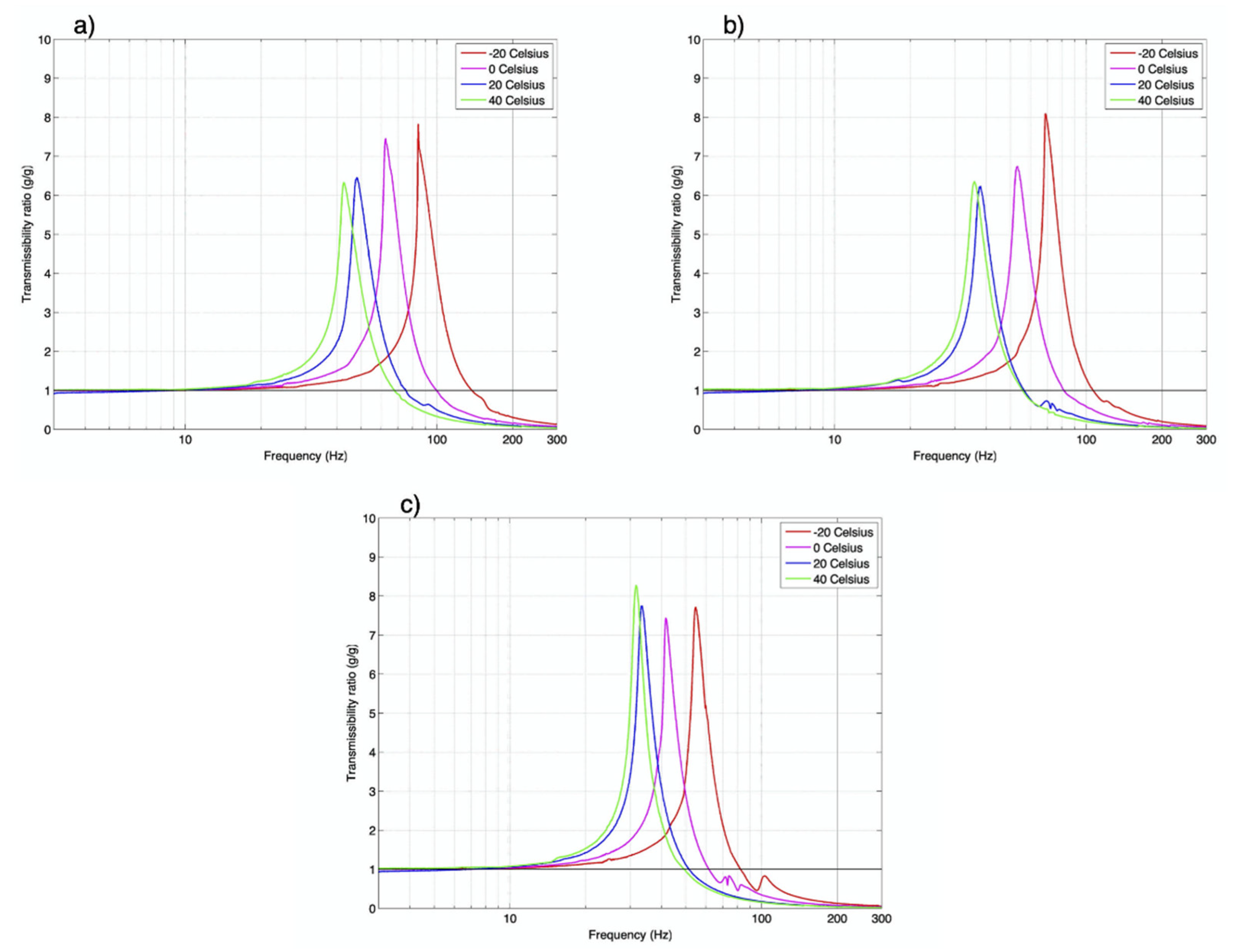
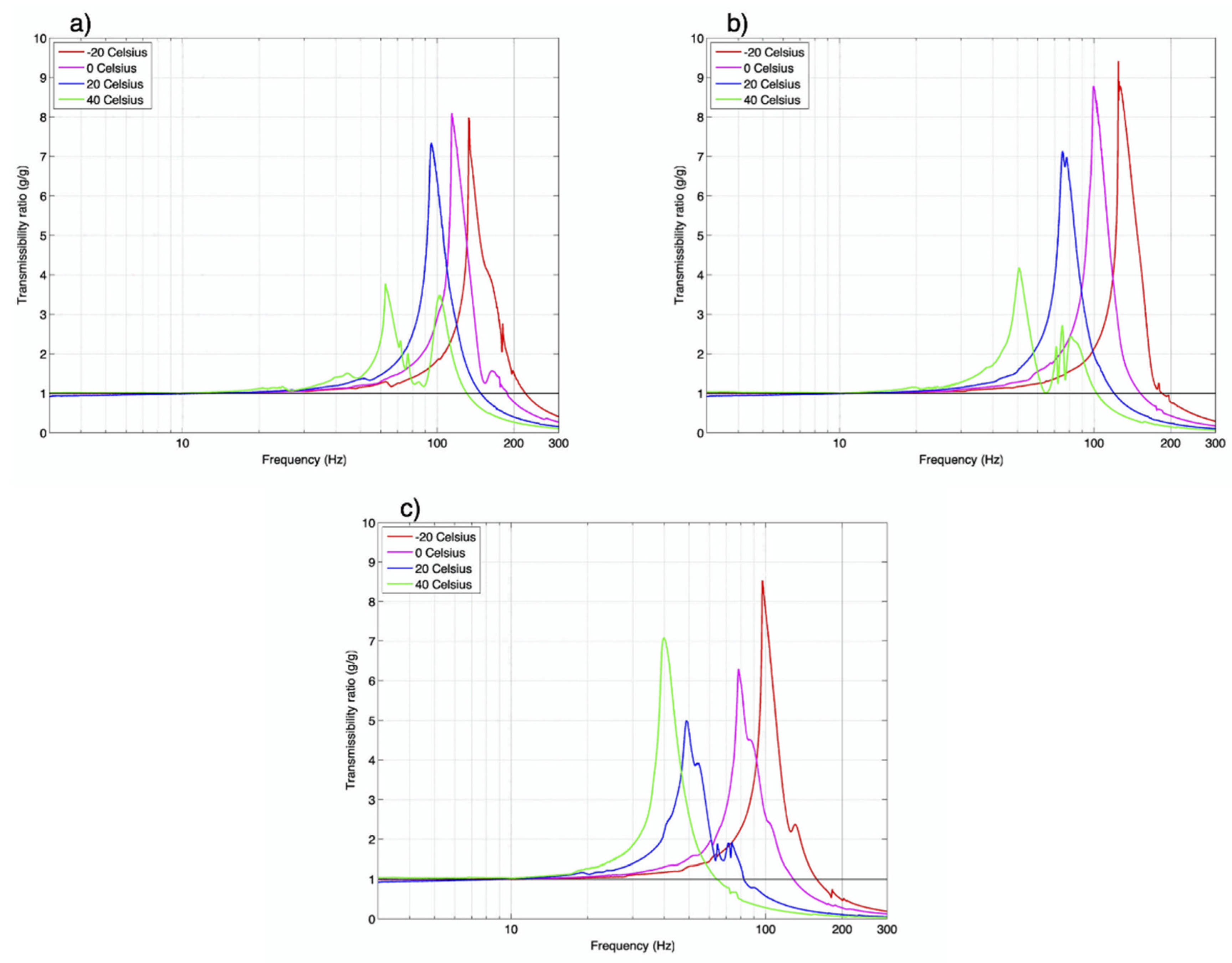

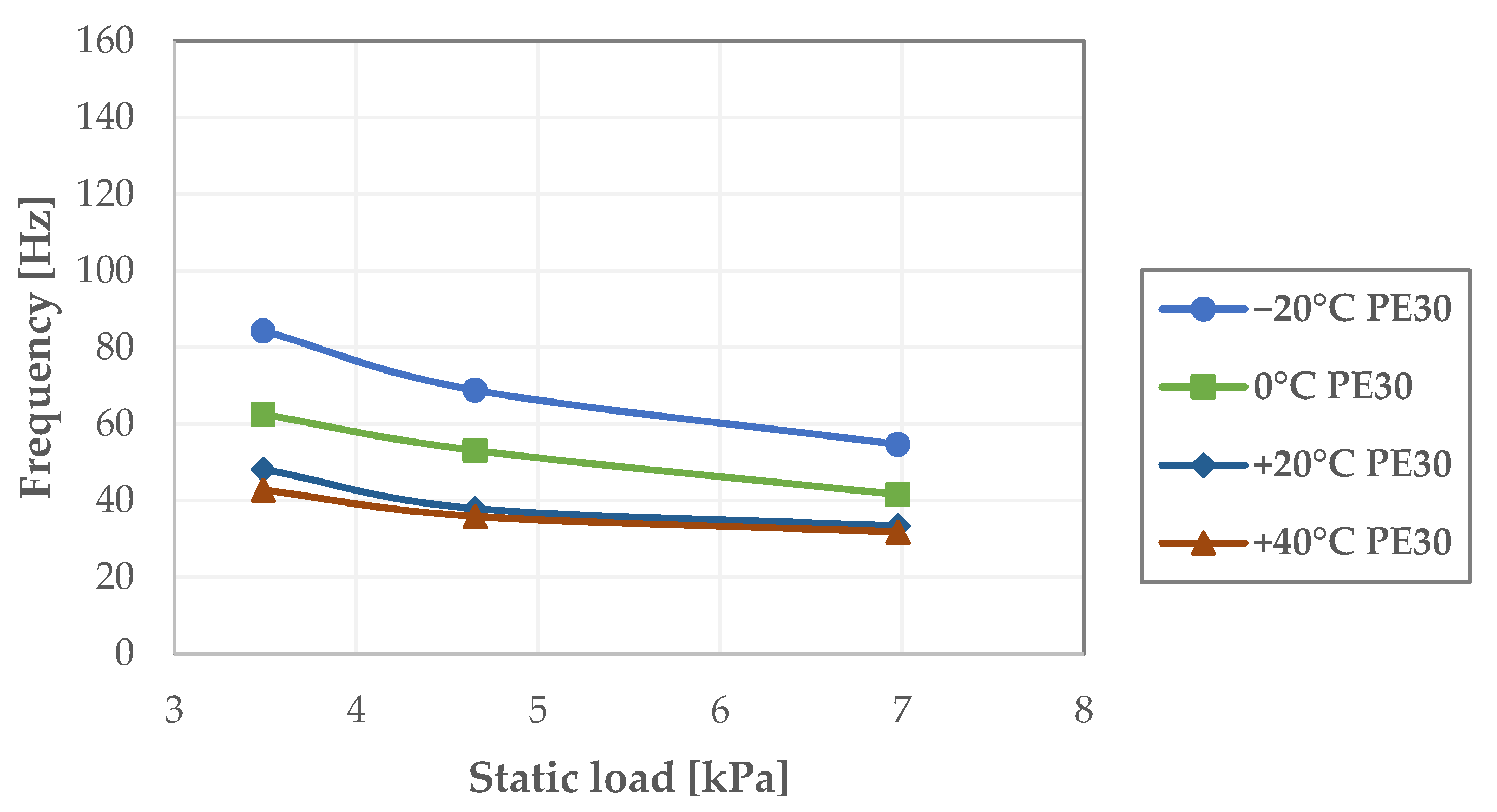

| Equipment | Manufacturer | Parameter | |
|---|---|---|---|
| Vibration Test System TV 59355/AIT-440 | TIRA GmbH (Germany) | Rated peak force Sinepk | max. 55,000 N |
| Frequency | max. 2500 Hz | ||
| Max. velocity Sine | 2.0 m/s | ||
| Max. acceleration Sine | 100 g | ||
| AV600 C 10 | Angelantoni Industrie Srl (Italy) | Useful capacity (L) | max. 610 |
| Temperature range (°C) | −75 to +180 | ||
| VR9500 | Vibration Research(USA) | Frequency range | DC to 50,000 Hz |
| Sample frequency | 10,000 Hz to 200,000 Hz | ||
| Sweep rate | Linear from zero to 100,000 Hz/min or logarithmic from zero to 100,000 octaves/min | ||
| Static Load [kPa] | Zone Interface | Temperature [°C] | ||||
|---|---|---|---|---|---|---|
| −20 | 0 | +20 | +40 | |||
| 3.488 | Direct coupling/amplification | Frequency [Hz] | 15.9398 | 13.9783 | 12.2300 | 12.0621 |
| Transmissibility | 1.1004 | 1.1016 | 1.1003 | 1.1007 | ||
| Damping ratio | 1.0890 | 1.0821 | 1.0894 | 1.0869 | ||
| Peak transmissibility | Frequency [Hz] | 44.4331 | 40.1499 | 34.0133 | 32.5566 | |
| Transmissibility | 8.8497 | 7.2479 | 6.7084 | 6.1717 | ||
| Damping ratio | 0.0565 | 0.0690 | 0.0745 | 0.0810 | ||
| Amplification/attenuation | Frequency [Hz] | 69.9528 | 63.9419 | 54.4190 | 52.4496 | |
| Transmissibility | 0.9900 | 0.9876 | 0.9948 | 0.9989 | ||
| Damping ratio | ||||||
| 4.651 | Direct coupling/amplification | Frequency [Hz] | 13.9783 | 12.4862 | 11.4133 | 10.6266 |
| Transmissibility | 1.1003 | 1.1012 | 1.1004 | 1.1026 | ||
| Damping ratio | 1.0894 | 1.0845 | 1.0886 | 1.0767 | ||
| Peak transmissibility | Frequency [Hz] | 42.6283 | 35.2904 | 31.0191 | 29.2830 | |
| Transmissibility | 9.2423 | 6.9581 | 7.0325 | 7.3457 | ||
| Damping ratio | 0.0541 | 0.0719 | 0.0711 | 0.0681 | ||
| Amplification/attenuation | Frequency [Hz] | 67.4213 | 57.1164 | 47.6126 | 45.8895 | |
| Transmissibility | 0.9940 | 0.9933 | 0.9979 | 0.9985 | ||
| Damping ratio | ||||||
| 6.976 | Direct coupling/amplification | Frequency [Hz] | 11.9790 | 11.5455 | 10.9497 | 10.1481 |
| Transmissibility | 1.1011 | 1.1006 | 1.1001 | 1.1007 | ||
| Damping ratio | 1.0851 | 1.0879 | 1.0908 | 1.0870 | ||
| Peak transmissibility | Frequency [Hz] | 35.9468 | 32.8580 | 29.3506 | 28.1584 | |
| Transmissibility | 9.2440 | 9.0860 | 9.6113 | 9.3520 | ||
| Damping ratio | 0.0541 | 0.0550 | 0.0520 | 0.0535 | ||
| Amplification/attenuation | Frequency [Hz] | 55.9444 | 51.1372 | 45.1554 | 43.9242 | |
| Transmissibility | 0.9976 | 0.9984 | 0.9903 | 0.9931 | ||
| Damping ratio | ||||||
| Static Load [kPa] | Zone Interface | Temperature [°C] | ||||
|---|---|---|---|---|---|---|
| −20 | 0 | +20 | +40 | |||
| 3.488 | Direct coupling/amplification | Frequency [Hz] | 28.1584 | 21.2592 | 17.0411 | 15.0825 |
| Transmissibility | 1.1003 | 1.1014 | 1.1012 | 1.1011 | ||
| Damping ratio | 1.0894 | 1.0834 | 1.0845 | 1.0849 | ||
| Peak transmissibility | Frequency [Hz] | 84.3035 | 62.4857 | 48.1642 | 42.7266 | |
| Transmissibility | 7.8330 | 7.4628 | 6.4579 | 6.2995 | ||
| Damping ratio | 0.0638 | 0.0670 | 0.0774 | 0.0794 | ||
| Amplification/attenuation | Frequency [Hz] | 137.706 | 99.7429 | 75.3045 | 67.8889 | |
| Transmissibility | 0.9956 | 0.9960 | 0.9950 | 0.9935 | ||
| Damping ratio | ||||||
| 4.651 | Direct coupling/amplification | Frequency [Hz] | 21.9055 | 17.7626 | 12.8658 | 12.1458 |
| Transmissibility | 1.1073 | 1.1010 | 1.1020 | 1.1013 | ||
| Damping ratio | 1.0517 | 1.0855 | 1.0797 | 1.0837 | ||
| Peak transmissibility | Frequency [Hz] | 68.8338 | 53.0573 | 37.9029 | 35.8641 | |
| Transmissibility | 8.0947 | 6.7340 | 6.1872 | 6.3288 | ||
| Damping ratio | 0.0618 | 0.0743 | 0.0808 | 0.0790 | ||
| Amplification/attenuation | Frequency [Hz] | 106.389 | 81.4401 | 56.5925 | 55.9444 | |
| Transmissibility | 0.9883 | 0.9977 | 0.9930 | 0.9937 | ||
| Damping ratio | ||||||
| 6.976 | Direct coupling/amplification | Frequency [Hz] | 17.2386 | 14.2383 | 11.9515 | 11.0511 |
| Transmissibility | 1.1006 | 1.1009 | 1.1050 | 1.1022 | ||
| Damping ratio | 1.0875 | 1.0860 | 1.0635 | 1.0789 | ||
| Peak transmissibility | Frequency [Hz] | 54.6703 | 41.5616 | 33.3922 | 31.8152 | |
| Transmissibility | 7.7215 | 7.4278 | 7.7390 | 8.2612 | ||
| Damping ratio | 0.0648 | 0.0673 | 0.0646 | 0.0605 | ||
| Amplification/attenuation | Frequency [Hz] | 82.3836 | 61.7701 | 51.4919 | 49.1732 | |
| Transmissibility | 0.9997 | 0.9937 | 0.9927 | 0.9938 | ||
| Damping ratio | ||||||
| Static Load [kPa] | Zone Interface | Temperature [°C] | ||||
|---|---|---|---|---|---|---|
| −20 | 0 | +20 | +40 | |||
| 3.488 | Direct coupling/amplification | Frequency [Hz] | 39.326 | 36.0297 | 30.9477 | 18.9899 |
| Transmissibility | 1.1002 | 1.1033 | 1.1028 | 1.1012 | ||
| Damping ratio | 1.0897 | 1.0729 | 1.0753 | 1.0846 | ||
| Peak transmissibility | Frequency [Hz] | 133.3350 | 114.5280 | 94.8137 | 62.6298 | |
| Transmissibility | 7.9639 | 8.0985 | 7.3446 | 3.7688 | ||
| Damping ratio | 0.0628 | 0.0617 | 0.0681 | 0.1327 | ||
| Amplification/attenuation | Frequency [Hz] | 222.36 | 188.808 | 148.241 | 130.9 | |
| Transmissibility | 0.9948 | 0.9824 | 0.9992 | 0.9939 | ||
| Damping ratio | ||||||
| 4.651 | Direct coupling/amplification | Frequency [Hz] | 36.7846 | 30.2429 | 25.9771 | 17.4785 |
| Transmissibility | 1.1030 | 1.1010 | 1.1025 | 1.1028 | ||
| Damping ratio | 1.0741 | 1.0852 | 1.0771 | 1.0754 | ||
| Peak transmissibility | Frequency [Hz] | 124.7180 | 99.5134 | 75.1312 | 50.6682 | |
| Transmissibility | 9.4144 | 8.7795 | 7.1330 | 4.1833 | ||
| Damping ratio | 0.0531 | 0.0570 | 0.0701 | 0.1195 | ||
| Amplification/attenuation | Frequency [Hz] | 184.934 | 152.396 | 119.928 | 102.303 | |
| Transmissibility | 0.9980 | 0.9945 | 0.9999 | 0.9959 | ||
| Damping ratio | ||||||
| 6.976 | Direct coupling/amplification | Frequency [Hz] | 29.1484 | 24.1309 | 16.3866 | 14.9786 |
| Transmissibility | 1.1043 | 1.1011 | 1.1002 | 1.1006 | ||
| Damping ratio | 1.0671 | 1.0849 | 1.0900 | 1.0878 | ||
| Peak transmissibility | Frequency [Hz] | 97.0233 | 78.3122 | 48.8345 | 39.8734 | |
| Transmissibility | 8.5342 | 6.2941 | 4.9942 | 7.0873 | ||
| Damping ratio | 0.0586 | 0.0794 | 0.1001 | 0.0705 | ||
| Amplification/attenuation | Frequency [Hz] | 158.849 | 128.806 | 82.0049 | 64.0894 | |
| Transmissibility | 0.9968 | 0.9919 | 0.9977 | 0.9971 | ||
| Damping ratio | ||||||
Publisher’s Note: MDPI stays neutral with regard to jurisdictional claims in published maps and institutional affiliations. |
© 2021 by the authors. Licensee MDPI, Basel, Switzerland. This article is an open access article distributed under the terms and conditions of the Creative Commons Attribution (CC BY) license (http://creativecommons.org/licenses/by/4.0/).
Share and Cite
Csavajda, P.; Böröcz, P. Effect of Temperature Changes on the Vibration Transmissibility of XPE and PE Packaging Cushioning Material. Appl. Sci. 2021, 11, 482. https://doi.org/10.3390/app11020482
Csavajda P, Böröcz P. Effect of Temperature Changes on the Vibration Transmissibility of XPE and PE Packaging Cushioning Material. Applied Sciences. 2021; 11(2):482. https://doi.org/10.3390/app11020482
Chicago/Turabian StyleCsavajda, Péter, and Péter Böröcz. 2021. "Effect of Temperature Changes on the Vibration Transmissibility of XPE and PE Packaging Cushioning Material" Applied Sciences 11, no. 2: 482. https://doi.org/10.3390/app11020482
APA StyleCsavajda, P., & Böröcz, P. (2021). Effect of Temperature Changes on the Vibration Transmissibility of XPE and PE Packaging Cushioning Material. Applied Sciences, 11(2), 482. https://doi.org/10.3390/app11020482






